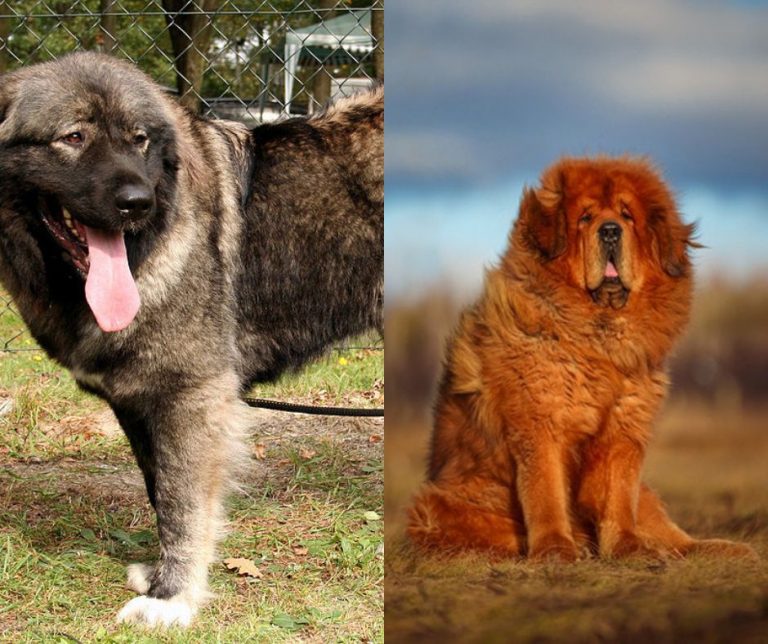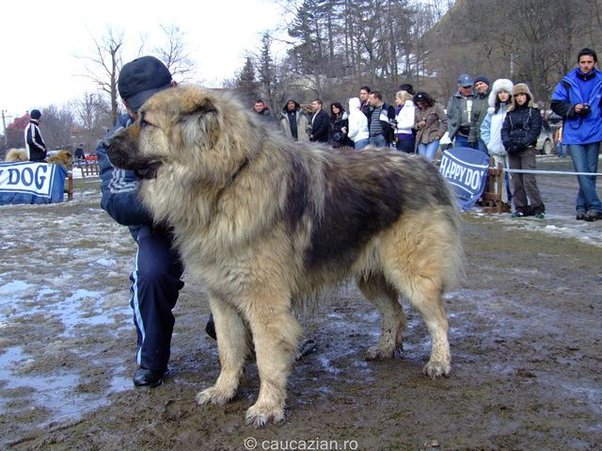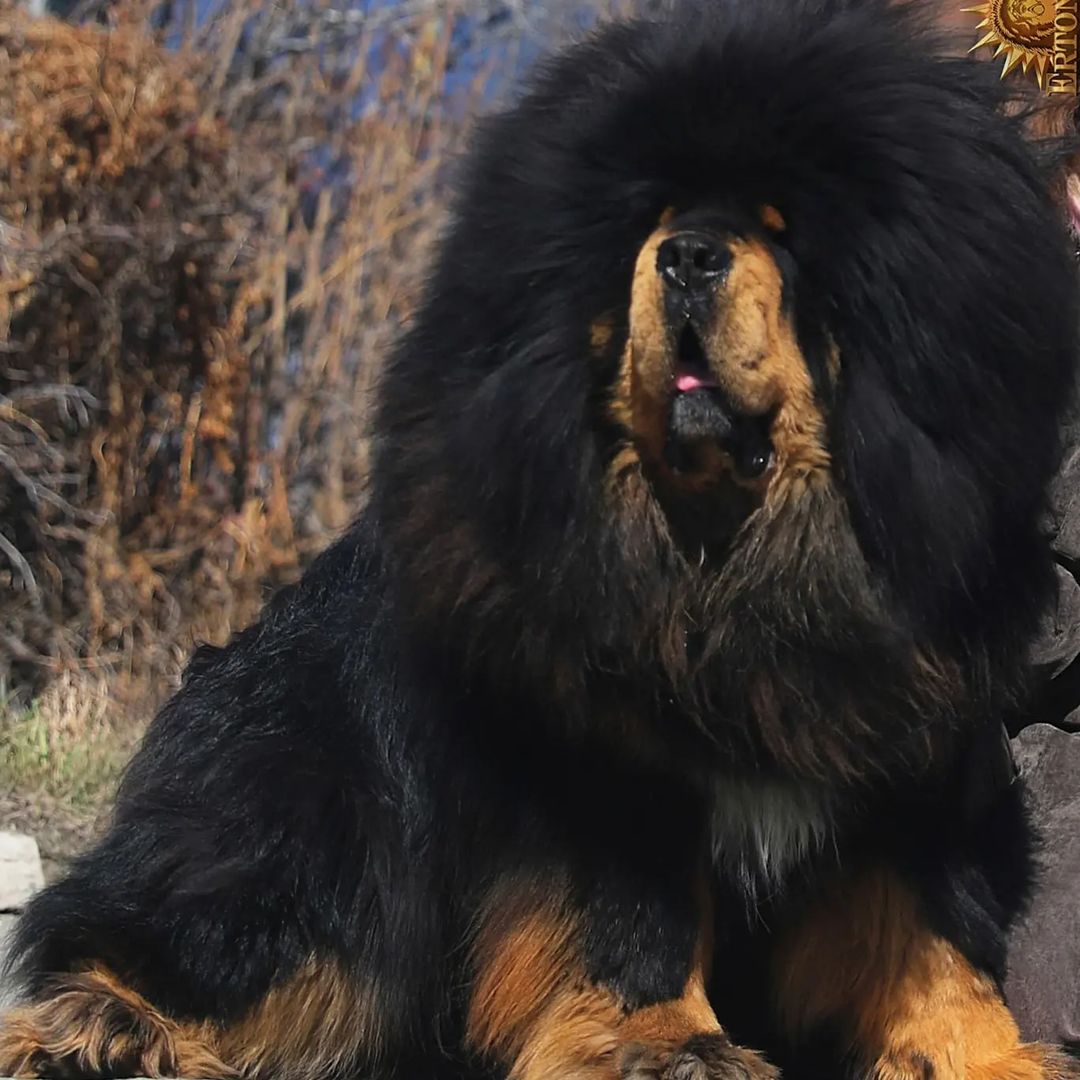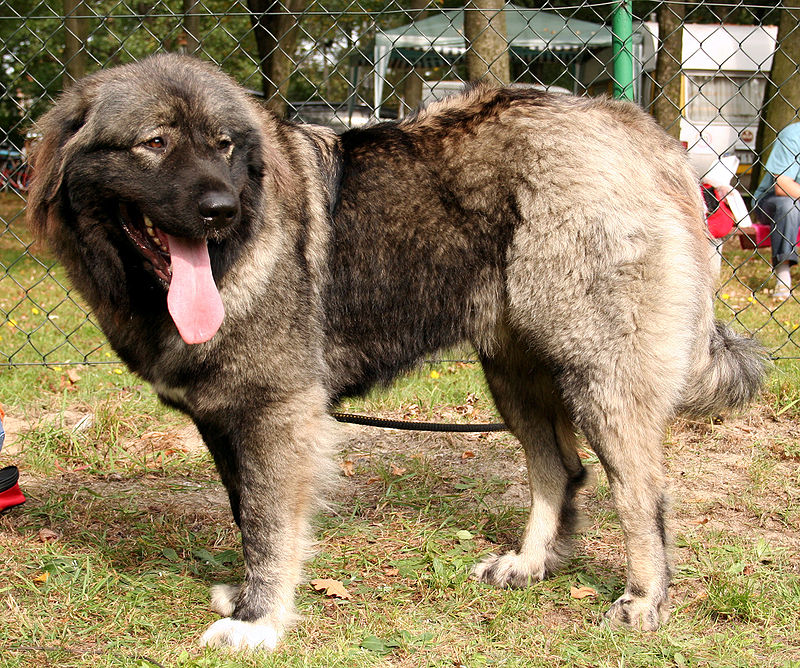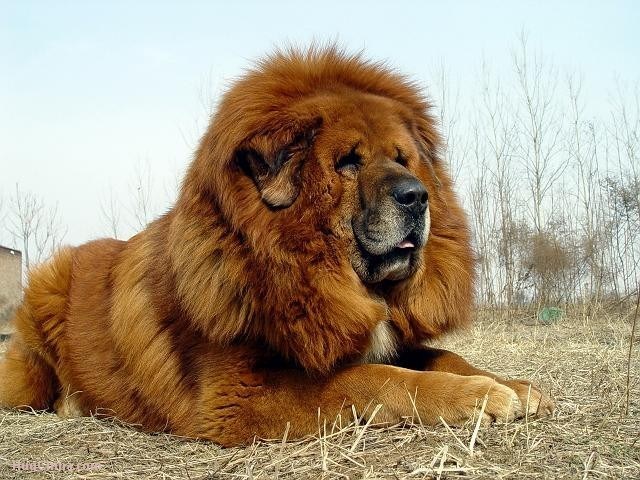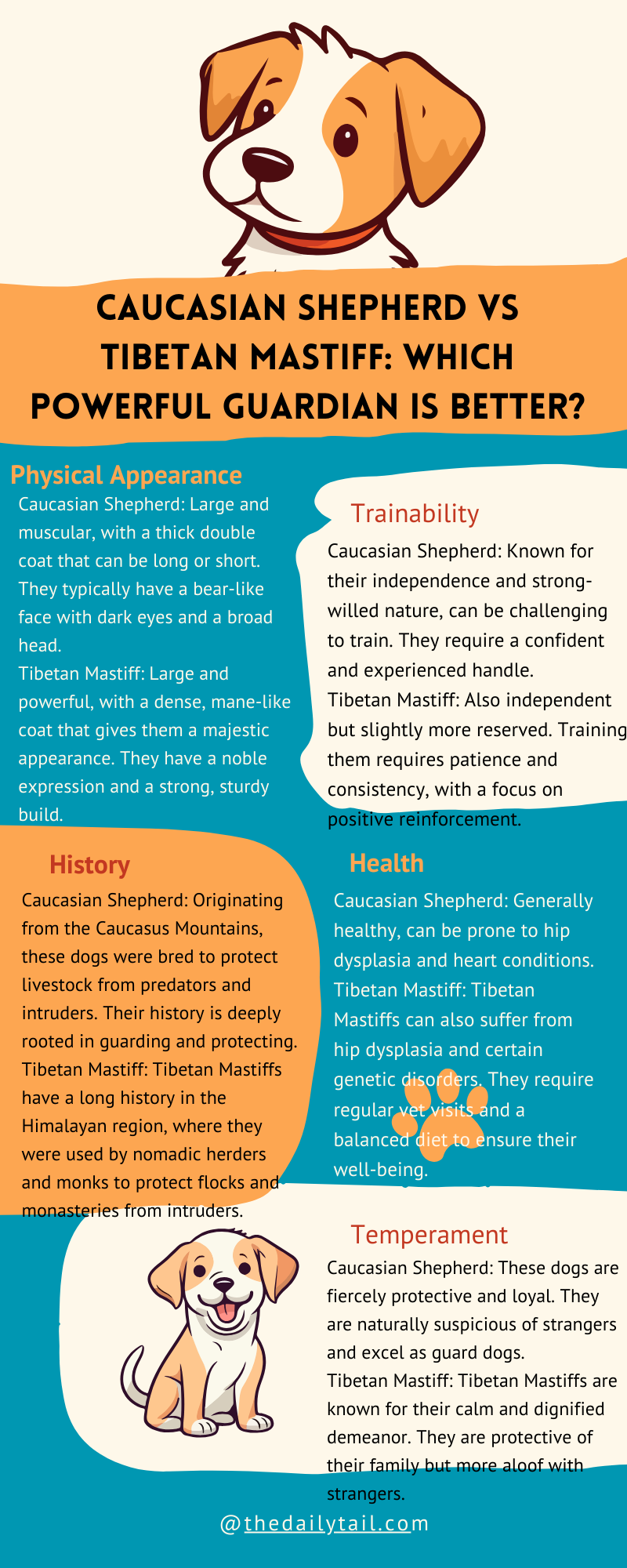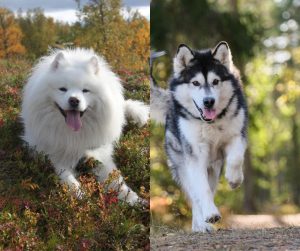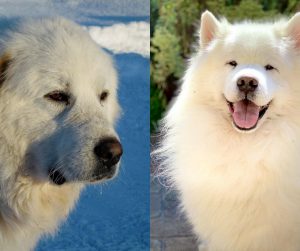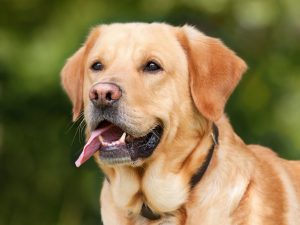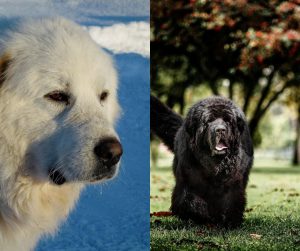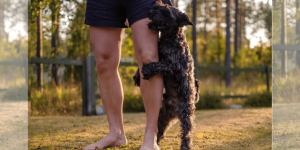If you want a strong, loyal protector, there are not many breeds that do a better job than the Tibetan Mastiff and Caucasian Shepherd. These two farm dogs can protect a large property without any issues.
And they are also giant fluffy dogs that love their family. Do not mistake a protector for an aggressive dog breed. The Caucasian Shepherd dog breed and Tibetan Mastiff dog breed are two canines that will go above and beyond for your protection.
Despite their similarities, they have their own unique histories and personalities that set them apart.
The Caucasian Shepherd hails from the Caucasus region where it was used to protect livestock. Meanwhile, the imposing Tibetan Mastiff has roots in the nomadic cultures of Tibet, where it also served as a safeguard against threats.
Both dog breeds possess a striking appearance, with the Tibetan Mastiff sporting a thick mane that gives it a lion-like look. On the other hand, the Caucasian Shepherd boasts a robust and muscular frame with a thick coat to keep it warm.
Their personalities are just as distinct. The Caucasian Shepherd tends to be fearless and assertive, willing to take on challenges head-on. In contrast, the Tibetan Mastiff is known to be more reserved and can be playful at times. They both may give off an air of independence, but they form strong bonds with their family.
It’s not just about which dog looks tougher or which one has a more playful streak, though. If you’re thinking of bringing one of these impressive breeds into your home, you’ll want to know about what it takes to train them, keep them healthy, and ensure they’re the perfect fit for your lifestyle. Their exercise needs, grooming requirements, and healthcare considerations all play a part in determining if either of these breeds is the right companion for you.
With that in mind, let’s take a look at the Caucasian Shepherd vs Tibetan Mastiff dog breed comparison. Which one is more powerful? Which one suits your lifestyle better? Let’s find out!
Key Takeaways
- The Caucasian Shepherd and Tibetan Mastiff are large, guard-oriented breeds with distinct origins and appearances
- They differ in personality, with the Caucasian Shepherd being bold and assertive, and the Tibetan Mastiff being more reserved and occasionally playful
- Considering factors like training, healthcare, and lifestyle compatibility are essential when choosing between these two breeds for a family pet
Breed Origins and History
The Caucasian Shepherd and Tibetan Mastiff are majestic dogs with rich histories rooted in mountainous terrains, where they stood as guardians for centuries. Their past is intertwined with the cultures and landscapes of their respective regions.
Origins of the Caucasian Shepherd
The Caucasian Shepherd Dog is a breed that hails from the Caucasus Mountains. This burly pooch has been a trusty protector of livestock against formidable wildlife, like wolves and bears. They’ve earnt a pretty impressive rep for their strength and courage over time. They’re also known by a few other names—it turns out a dog this cool can’t stick to just one!
- Also Known As:
- Caucasian Ovcharka
- Kawkasky Owtscharka
- Kaukasische Schaferhund
- Caucasian Sheepdog
These fluff giants aren’t just recent additions to the dog world. Nope, they’ve been around for roughly 2,000 years! Their ancestors are believed to be ancient Molosser dogs, and it’s probable that the powerful Tibetan Mastiff played a part in their lineage.
History of the Tibetan Mastiff
On the flip side, we’ve got the Tibetan Mastiff, equally imposing, with a story that’s woven into the fabric of Tibetan culture. These dogs are synonymous with the might and mystique of the Himalayas. They stood watch over monasteries and homes, traditionally guarding against any trouble with a calm but commanding presence.
- Place in History:
- Ancient guard dogs in Tibet
- Protectors of monasteries and nomadic tribes
- Known for their devotion and independence
They weren’t just any regular dogs. Tibetan Mastiffs were regarded as both protectors and symbols of status. It’s even believed that Genghis Khan and Buddha had their own squads of these loyal canine companions. Recognized by dog clubs like the American Kennel Club, the Tibetan Mastiff has gone from monastery gates to being appreciated worldwide for their noble character and impressive bearing.
Physical Features and Appearance
When you compare Caucasian Shepherd vs Tibetan Mastiff, you notice distinct differences in their looks. From their striking coat colors to their impressive size, each breed has its own unique set of physical characteristics.
Caucasian Shepherd Looks
The Caucasian Shepherd is quite the big dog, often seen as a furry giant. They stand at a height of around 26 to 30 inches, and they’re pretty tall. They tip the scales too, usually weighing in at about 99 to 170 pounds. This breed sports a double coat, which offers protection from harsh weather, and they shed quite a lot.
When it comes to coat colors, they arrive in a variety of shades including white, black, red, fawn, cream, and grey. This dog’s appearance gives off a strong and sturdy vibe—no wonder they’re considered excellent guard dogs.
Tibetan Mastiff Looks
The Tibetan Mastiff is no less impressive with its height typically around 24 inches and weighs a bit less, most topping out around 150 pounds. They’re known for their striking double coat, which can be found in colors like black, brown, blue-gray, and red gold.
Their mane of hair around the neck makes them look regal, almost lion-like. The fluffiness of their coat often tricks the eye into thinking they’re heftier than they actually are. They might look like gentle giants, all fluffy and cuddly, but these dogs carry a look of nobility and wisdom in their eyes.
Personality and Temperament
As I said in the beginning, these two are different dogs. They look different, and act too. Their character is unique. While both dog breeds are loyal and protective, they achieve it differently. Let’s talk about the Caucasian Shepherd vs Tibetan Mastiff personality comparison.
The Nature of the Caucasian Shepherd
The Caucasian Shepherd is known for being a strong-willed guard dog. They are fiercely loyal to their families, and they have an inborn drive to protect.
This breed demands respect and thrives on trust-based relationships with its owners. With their kind and loving nature, they make good companions, showing a softer side to the family they guard.
However, they are also known for their independent temperament, which could be challenging for first-time dog owners. When interacting with children or new people, it’s important for these dogs to have proper training and socialization.
- Traits: Loyal, Protective, Independent, Calm (when trained)
- Family Pet: Yes (with proper training)
- Guardian Ability: Excellent
The Character of the Tibetan Mastiff
In contrast, the Tibetan Mastiff displays a slightly more energetic personality compared to the Caucasian Shepherd. They are intelligent, fearless, and equally protective of their loved ones.
This breed is known for being affectionate with their family, showcasing a loving and patient attitude, especially towards children.
Tibetan Mastiffs carry a majestic presence but aren’t seeking constant attention; they value their independence too.
In their role as guardians, they are dependable and will stand their ground when they sense a threat, making them reliable guard dogs.
- Traits: Intelligent, Affectionate, Energetic (compared to Caucasian Shepherd), Territorial
- Family Pet: Yes (with a family that understands their needs)
- Guardian Ability: Very Good
Training and Exercise Needs
When preparing to train a Caucasian Shepherd or a Tibetan Mastiff, it’s important to approach these independent breeds with patience. Both require lots of exercise to stay healthy and happy, but their training needs can be quite unique.
Keeping Your Caucasian Shepherd Busy
This big dog is no couch potato. A Caucasian Shepherd’s exercise regimen should include daily, long walks and space to roam.
In terms of training, they can be a bit headstrong. Owners need to be firm and consistent. These dogs respond best to clear, confident commands and positive reinforcement, like praise and treats.
But don’t forget their mind needs a workout too. Puzzle toys and new tricks provide necessary mental stimulation, keeping that impressive brain engaged.
Engaging Your Tibetan Mastiff
Tibetan Mastiffs are, by nature, playful and protective. They have a lower energy level than Caucasian Shepherds but don’t mistake that for laziness—they too need daily exercise.
As for their brains, these guys love a good challenge. Keep this in mind during training sessions which should be short to keep them from getting bored.
They’re a bit difficult to train due to their independent streak, so it’s all about that bond of mutual respect.
Remember, socialization is key, and just like their fluffy counterparts, rewards and positive reinforcement make for a happier and more cooperative Tibetan Mastiff.
Healthcare and Lifespan
When it comes to the health and longevity of giant dog breeds, consistent care and awareness of breed-specific issues are key. Both Caucasian Shepherds and Tibetan Mastiffs need their humans to keep a close eye on nutrition and common health problems. Let’s explore what keeping these magnificent dogs healthy entails.
Caucasian Shepherd Health Focus
The Caucasian Shepherd is one robust dog, typically living between 10 to 12 years. To help him reach his golden years in good shape, here’s what owners should look out for:
- Grooming: They have a thick coat that requires regular brushing to prevent mats, especially during shedding seasons
- Ears and Eyes: Regular checks are necessary, as they can develop problems like entropion, which affects the eyelids
- Hip and Elbow Dysplasia: These are common in large breeds and can be managed with proper care and attention to body condition
- Nutrition: It’s important to provide a balanced diet to prevent obesity, which can further strain joints
- Canine Inherited Demyelinative Neuropathy (CIDN): A rare inherited condition that can occur in this breed
Good, consistent grooming routines keep their coat clean and free from mats, which is not just about looks but also about health.
Tibetan Mastiff Health Check
Tibetan Mastiffs share a similar life expectancy to the Caucasian Shepherd, with a healthy one living 10-12 years on average. For a happy life, their healthcare should include:
- Grooming: They too have a double coat that needs regular brushing to manage the heavy shedding
- Hip Dysplasia: This condition is also seen in Tibetan Mastiffs and can be mitigated with appropriate diet and exercise
- Hypothyroidism: This gland issue is something to watch for; it can affect their metabolism and overall health
- Obesity: Preventing weight gain is crucial to avoid extra stress on their joints
- Eye Care: Regular checks help catch conditions like entropion early on
Breed Comparison and Choosing the Right Dog for You
When picking between the Caucasian Shepherd and the Tibetan Mastiff, it’s all about understanding their traits and how they might fit into your daily life and your family.
Caucasian Shepherd vs Tibetan Mastiff
The Caucasian Shepherd and the Tibetan Mastiff are both impressive dogs with a strong presence. Here’s a breakdown of what sets them apart:
Size:
- The Caucasian Shepherd is typically very large, with some dogs weighing well over 100 pounds
- Tibetan Mastiffs are big too, but they tend to be slightly lighter in weight
Coat:
- Both breeds have thick, fluffy coats that require regular grooming
- The shedding season can be a real chore with these dogs, so get ready to have a good vacuum on hand
Temperament:
- Caucasian Shepherds are known to be fiercely protective, which makes them excellent guard dogs against threats like wolves, bears, or thieves
- Tibetan Mastiffs share that protective instinct, but they can also be more independent in nature
Family Compatibility:
- With proper socialization, both breeds can interact well with children and can become a loyal family pet
- They can be playful, but it’s essential to teach children how to properly interact with such large dogs
Protection:
- These dogs aren’t just for show; they mean business. Their history includes guarding livestock and property, and they take their job seriously
Price:
- Be ready to open your wallet. Both breeds can be quite costly, not just to buy, but also considering their nutritional needs and health care
Key Considerations for a Family Dog
Choosing either a Caucasian Shepherd or a Tibetan Mastiff as a family dog means thinking about a few important things:
- Space: Big dogs need plenty of room
- They’ll fit in better at a place with a big yard or lots of space to roam and play
- Socialization: It’s vital to introduce these dogs to various people and pets early on
- This helps prevent any aggressive behavior towards strangers or other animals
- Protection: If you’re looking for a guard dog, you’re in luck
- Both breeds are natural protectors
- Kids: Gentle yet firm teaching is needed so that kids know how to be safe around these powerful pups
- Energy: While they may look like they just want to sit around and look majestic, both breeds enjoy being active and need regular exercise

